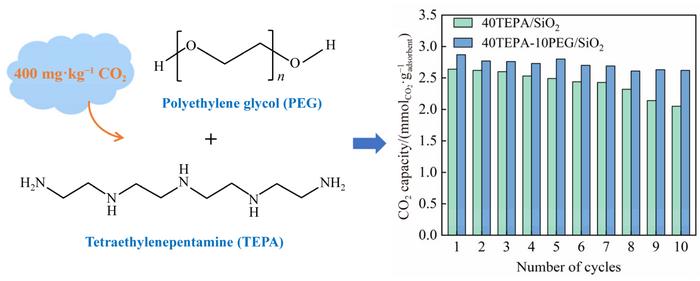In a groundbreaking study that underscores the urgency of combating climate change, researchers from East China University of Science and Technology and Tsinghua University have developed a revolutionary adsorbent designed to enhance direct air capture (DAC) technology. This state-of-the-art adsorbent demonstrates significant potential in effectively capturing carbon dioxide (CO2) directly from the atmosphere, thus presenting a promising avenue towards achieving carbon neutrality.
The research focuses on an innovative adsorbent made from tetraethylenepentamine-functionalized silica gel (SiO2). The pivotal advancement lies in the introduction of specific additives that significantly improve the adsorbent’s efficiency and stability in capturing CO2 under real-world conditions. This breakthrough comes at a critical time, as the global community amplifies its efforts to mitigate the impacts of climate change, and the search for viable carbon capture solutions becomes increasingly urgent.
In the published study, the research team highlights the primary challenge of DAC technology: the low concentration of CO2 present in the atmosphere. Traditional methods often struggle to efficiently capture CO2 at these low levels. However, the newly engineered adsorbent effectively addresses this limitation by maximizing the number of active amine sites through the strategic incorporation of additives into its structure. This crucial enhancement means that the new adsorbent can interact with and capture CO2 more effectively than prior solutions, marking it as a notable advancement in the field.
Dr. Zhenmin Cheng, the lead author of the study, articulated the significance of their findings, stating that the intentional incorporation of these additives allowed the adsorbent to exhibit remarkable properties. It was found that the additive-infused structure not only improves CO2 capture rates but also enhances the overall stability of the adsorbent during multiple adsorption-desorption cycles. In laboratory trials, the adsorbent consistently exhibited an impressive CO2 capture capacity, showcasing its robustness even after undergoing accelerated oxidation treatments.
The adsorbent, aptly named 40TEPA10PEG/SiO2, comprises 40% tetraethylenepentamine combined with 10% polyethylene glycol, demonstrating an impressive CO2 capture capacity of 2.1 mmol·g–1. Over 20 cycles, the adsorbent displayed a commendable amine efficiency of 0.22, cementing its position as a contender in the ongoing fight against climate change. Even with rigorous testing that simulated harsh operational conditions, the adsorbent retained a CO2 capture capacity of 2.0 mmol·g–1, a testament to its stability under stress.
The significance of stability in DAC applications cannot be overstated. With the potential for this technology to be deployed at a larger scale, having a highly stable adsorbent is crucial for maximizing economic viability. The researchers noted that the performance of the adsorbent is profoundly impacted by the quantity of active amine sites. By optimizing the content of tetraethylenepentamine and other additives, they foresee enhancing the adsorbent’s overall performance even further.
In broad terms, the successful development of such an efficient adsorbent could redefine the landscape of carbon capture technology, facilitating the implementation of DAC systems. These systems are pivotal for reaching negative carbon emission goals—where more CO2 is removed from the atmosphere than is emitted. The advancement not only offers hope in achieving these essential targets but also motivates ongoing research into cost-effective solutions for large-scale deployment.
As Dr. Cheng emphasized, by increasing the efficiency and durability of adsorbents used in DAC technology, researchers can assist in making this critical tool more pragmatic and appealing for widespread adoption. The adage of fighting climate change necessitates immediate, actionable solutions that could significantly cut atmospheric CO2 levels, and 40TEPA10PEG/SiO2 represents a essential step towards this goal.
The research team is poised to take the next steps in their investigation by exploring the optimization of the adsorbent further. Their future endeavors will include rigorous testing under real-world conditions to ensure the longevity and efficacy of the material outside laboratory settings. Additionally, they plan to investigate the potential of the adsorbent when utilized synergistically with existing carbon capture and storage frameworks, which could create an interdisciplinary approach for comprehensive carbon management.
Ultimately, this innovative study showcases the remarkable potential for advanced materials to address pressing global challenges. As society grapples with escalating environmental concerns, innovations like the new adsorbent for DAC technology could pave the way for a more sustainable future, allowing for the more effective management of greenhouse gas emissions while fostering a cleaner, greener planet for generations to come.
In conclusion, the advent of the 40TEPA10PEG/SiO2 adsorbent marks a significant development in the search for efficient CO2 capture solutions. By leveraging additives to enhance the functionality of traditional adsorbents, researchers are paving the way for new methods of carbon reduction that could change the course of our climate trajectory. As efforts ramp up globally to tackle the climate crisis, studies like this illuminate the path forward, emphasizing the critical role that scientific innovation plays in shaping a sustainable future.
Subject of Research:
Article Title: Structure-performance relationship of additive-incorporated tetraethylenepentamine-functionalized SiO2 in direct air capture of CO2
News Publication Date: 15-Feb-2025
Web References:
References:
Image Credits: Zuoyan Yang, Yuqi Zhou, Hongjie Cui, Zhenmin Cheng, Zhiming Zhou




